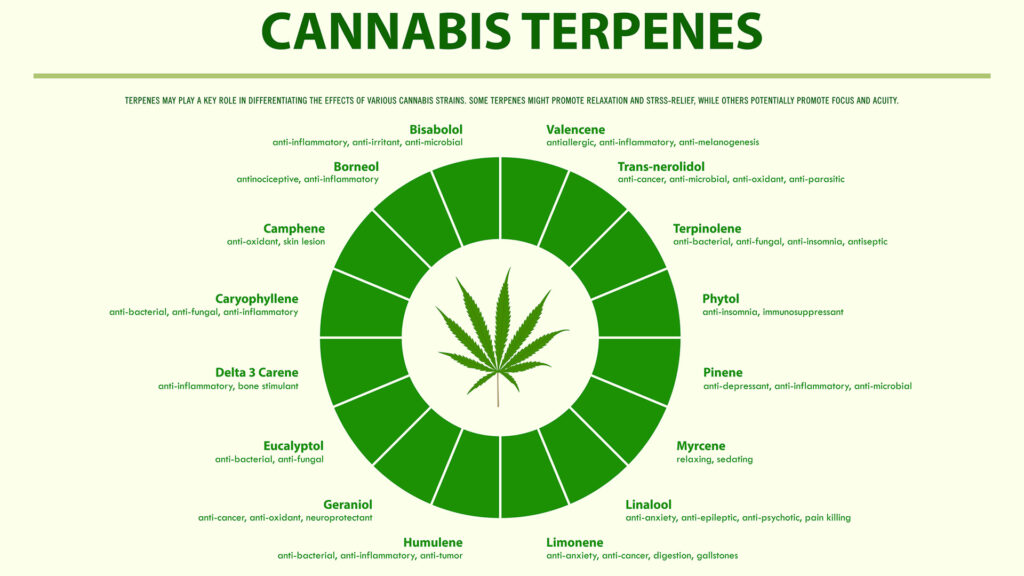Introduction
Cannabinoids and terpenes are natural compounds found in cannabis plants, each playing a significant role in the overall effects and therapeutic potential of cannabis. Understanding the difference between these two groups of compounds is crucial for individuals seeking to gain a comprehensive knowledge of cannabis and its applications. In this guide, we will delve into the world of cannabinoids and terpenes, exploring their unique characteristics, effects, and potential benefits.
Table of Contents
What Are Cannabinoids
- Definition
- Types of Cannabinoids
- Effects and Benefits
- Common Cannabinoids and Their Properties
What Are Terpenes
- Definition
- Types of Terpenes
- Effects and Benefits
- Common Terpenes and Their Properties
The Relationship between Cannabinoids and Terpenes
- Entourage Effect
- Synergistic Effects
- Examples of Cannabinoid-Terpene Interactions
Extraction and Consumption Methods
- Cannabis Extracts
- Consumption Methods
- Choosing the Right Product Based on Cannabinoids and Terpenes
Medical and Therapeutic Applications
- Pain Relief and Anti-Inflammatory Effects
- Anxiety and Stress Reduction
- Sleep Aid and Sedation
- Neuroprotective Properties
- Other Potential Benefits
Legal Considerations
- Regulatory Status of Cannabinoids and Terpenes
- 6.2 Hemp-Derived Cannabinoids and Terpenes
- Medical and Recreational Cannabis Laws
Conclusion
What Are Cannabinoids?
- Definition
Cannabinoids are a group of chemical compounds primarily found in cannabis plants. They interact with the endocannabinoid system (ECS) in the human body, which regulates various physiological processes such as pain, mood, appetite, and sleep.
- Types of Cannabinoids
There are over 100 known cannabinoids, with the most well-known being tetrahydrocannabinol (THC) and cannabidiol (CBD). THC is known for its psychoactive effects, while CBD is non-psychoactive but offers various potential therapeutic benefits.
- Effects and Benefits:
Cannabinoids can produce a range of effects, including pain relief, relaxation, euphoria, and anti-inflammatory properties. Additionally, cannabinoids have shown potential in managing conditions such as epilepsy, multiple sclerosis, and chemotherapy-nduced nausea.
- Common Cannabinoids and Their Properties
- Tetrahydrocannabinol (THC): Known for its psychoactive effects and potential pain-relieving properties.
- Cannabidiol (CBD)Non-psychoactive compound with potential anti-inflammatory, analgesic, and anxiolytic effects.
- Cannabinol (CBN) Believed to have sedative effects and potential for use as a sleep aid.
- Cannabigerol (CBG): Considered a minor cannabinoid with potential antibacterial and anti-inflammatory properties
What Are Terpenes
- Definition:
Terpenes are aromatic compounds found in various plants, including cannabis. They are responsible for the distinctive scents and flavors associated with different cannabis strains. Terpenes also have therapeutic potential and interact synergistically with cannabinoids
- Types of Terpenes
- 2.2 Types of Terpenes
There are hundreds of terpenes found in cannabis, each contributing to the unique aroma and effects of different strains. Here are some common terpenes found in cannabis
- Myrcene: This terpene is commonly found in cannabis and has a musky, herbal aroma. It is known for its potential sedative, relaxing, and anti-inflammatory effects. Myrcene is also found in hops, which is why some strains of cannabis and beer share similar scents.
- Limonene: As the name suggests, limonene has a citrusy aroma. It is found not only in cannabis but also in various citrus fruits. Limonene is associated with potential mood elevation, stress relief, and anti-anxiety effects
- Pinene: This terpene has a distinct pine scent and is also found in conifer trees. Pinene is believed to have potential anti-inflammatory properties and may act as a bronchodilator, helping to open up the airways.
- Linalool: Linalool is a floral-scented terpene found in lavender, coriander, and other plants. It is known for its potential calming and relaxing effects, making it useful for managing anxiety and promoting sleep
- Caryophyllene: This spicy terpene is found in black pepper, cloves, and other herbs and spices. Caryophyllene is unique as it can also interact with the body’s endocannabinoid system, potentially providing anti-inflammatory and pain-relieving effects.
- Effects and Benefits
Terpenes have various effects on the human body and can work synergistically with cannabinoids to enhance or modify their effects. While more research is needed, some potential benefits of terpenes include anti-inflammatory, analgesic, anti-anxiety, and sedative properties. Additionally, terpenes may contribute to the entourage effect, which we will discuss in the following section.
- Common Terpenes and Their Properties
While we highlighted a few common terpenes above, it’s essential to note that there are many more terpenes found in cannabis, each with its own unique properties. Some additional terpenes found in cannabis include humulene, terpinolene, ocimene, and geraniol. Each terpene contributes to the overall aroma and potential effects of cannabis strains.
The Relationship between Cannabinoids and Terpenes
- Entourage Effect
The entourage effect refers to the synergistic interaction between cannabinoids, terpenes, and other compounds in cannabis. When these components work together, they can enhance or modify the overall therapeutic effects of cannabis. For example, certain terpenes can potentially enhance the absorption of cannabinoids or influence their effects by interacting with receptors in the body.
- Synergistic Effects
Cannabinoids and terpenes can have individual effects, but when combined, their potential benefits may be amplified. For instance, myrcene, a terpene found in high concentrations in some cannabis strains, is believed to enhance the sedative effects of THC. Similarly, the combination of limonene and CBD may contribute to a more uplifting and energizing experience.
- Examples of Cannabinoid-Terpene Interactions:
- Myrcene and THC: Myrcene is believed to increase the permeability of cell membranes, allowing cannabinoids like THC to be absorbed more efficiently. This interaction may contribute to the sedative and relaxing effects commonly associated with indica strains.
- Pinene and CBD: Pinene has been shown to potentially counteract some of the memory impairment associated with THC. Additionally, it may have anti-inflammatory properties that complement the potential anti-inflammatory effects of CBD.
- Linalool and THC

